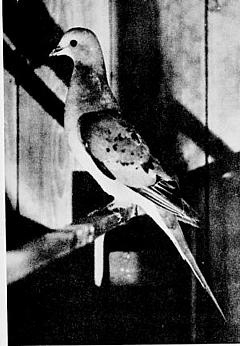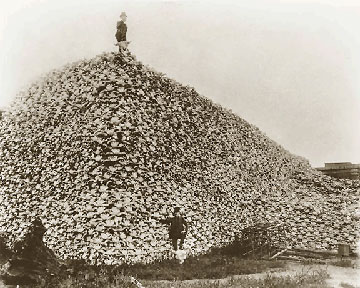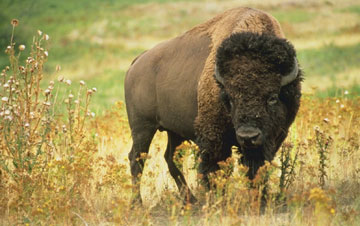Empty of People, Overrun by Pigeons
Demise of passenger pigeon linked to Lyme disease
Tina Butler, mongabay.com
November 14, 2005
Traditionally, the passenger pigeon has been held as one of the more beloved animal species to fall prey to humankind’s often relentless expansion into and disregard for the natural world and its creatures. Once abundant, the bird experienced a rapid decline in the late 1800s, due almost entirely to rampant hunting, and the last passenger pigeon died in 1914. In light of new findings however, this image of a naturally plentiful species laid to waste by man is now being tested. Evidence collected over the past few years from a significant number of Native American archeological sites is beginning to upset long-accepted beliefs about one of the most famous extinct species in modern history.
It has been widely accepted for centuries that the initial European contact in the 1500s had a profound impact on the native populations of the New World. Beyond violent clashes in battle, the headiest violence to affect Native Americans was foreign disease, resulting in the decimation of various tribes throughout North and South America through epidemics of European illnesses. The massive reduction in human population had serious ramifications for other native species, in ways that are still emerging today.
The essential emptying of two continents created a major imbalance in the food web and altered the very landscape. Many plant and animal species that were traditionally consumed by humans ballooned to abnormally high levels, known as “outbreak populations.” Among these species were several types of oak, bison and of special interest and importance, the passenger pigeon.
The passenger pigeon, in actuality, is believed by a growing number of experts to be a major indicator of changing human populations before, during and after the European conquest and the subsequent effect on the populations of other species. By studying burial sites of native inhabitants, archeologists and scientists anticipated the recovery of large amounts of passenger pigeon bones due to documentation of truly massive numbers of the species in the 1700s and 1800s. To their great surprise, there was a dearth of bones from this species at former settlement locations.
 1898 Photograph of a Passenger Pigeon. The last wild Passenger Pigeon was shot by a 14-year-old boy in Ohio in 1900, while the last known individual of the passenger pigeon species, named “Martha” after Martha Washington, died at 1 p.m. on the 1st of September 1914 in the Cincinnati Zoological Garden. She was 29. |
Scientists anticipated the recovery of many pigeon bones not simply for their impressive numbers, but also for their noted stupidity. The passenger pigeon, known for its voracious appetite and tendency for gorging, possessed the habit of gathering in great hordes. Crowding together in this way would have made the birds a very easy animal to hunt for the Native Americans. As was revealed centuries later, colonists had no problems obliterating the birds in single hunts, taking hundreds of thousands of animals at a time. One such hunt recorded the slaughter of 1.5 million passenger pigeons.
Competition with humans for food likely aided in keeping the passenger pigeon population low. The bird’s diet was largely comprised of tree nuts, acorns and maize. These were also the staples of certain Native American tribes; so keeping this species in check was of special interest to the people. Other animals consumed the same foods, and local inhabitants hunted these species with great enthusiasm, as remains in archeological sites reveal. Following this logic, scientists expected to find pigeon bones.
Some archeologists initially argued that the bird bones were too small to remain intact over the centuries, however the recovery of even lesser species’ bones, such as smaller birds and frogs, from ancient settlement sites proves otherwise. What can then be determined from this record — this paucity of bone remains — is that prior to European contact and subsequently, disruption of the environment, the passenger pigeon was a rare species.
This bone record, or lack thereof, contrasts sharply with stories of the species’ overwhelming presence in the previous centuries. In the early 1800s, there were eyewitness reports of pigeon flocks of epic proportions. The noted naturalist and artist, John James Audubon recalled a flock that passed overhead continuously in a single mass for three entire days. In his journal, he compared the effect from the shadow of the birds to an eclipse. Upon arriving at their roost, Audubon found the ground covered in almost two inches of bird droppings.
 Photograph from the mid-1870s of a pile of American bison skulls waiting to be ground for fertilizer. During the 19th century, hunting played a major role in the extirpation or near extirpation of many species such as the passenger pigeon, bison, pronghorn, elk and bighorn sheep. Since that time, habitat destruction has replaced commercial hunting as the leading cause of species decline and extinction. |
Arlie W. Schorger, an avian specialist, estimates that an astonishing one out of every four birds in North America was a passenger pigeon in Audubon’s time (1785-1851). With all of this evidence of a decidedly robust species, perhaps even overly robust, the gap in the reports and what archeologists have failed to recover has been a puzzling one to close. This fairly new theory of outbreak species, when applied to the case of the passenger pigeon, sheds new light on the mysterious trajectory of the species’ rise and dramatic fall.
The passenger pigeon’s role in environmental interference does not end in history. Last December, a study was published in the journal “Proceedings of the National Academy of Sciences” reported that one in ten species of birds in the world would become extinct by this century’s end. This represents a sobering future for not only the avian world, but also the human one. The extinction of a particular bird species is no small matter. Such an incidence may have catastrophic effects on human populations, not just in terms of a possible disturbance in the food web or ecological balance, but also may aid in the spread of disease.
 American Bison. USDA photo by Jack Dykinga. In the 19th century when settlers moved westward across the Great Plains of the United States they encountered, and slaughtered, massive herds of buffalo. The huge numbers of buffalo found by these Americans were likely the sign of an outbreak population. In his book 1491: New Revelations of the Americas Before Columbus, proposes that before the arrival of Europeans, North American Indians regulated the population of bison through hunting and the management of grasslands. It was only once native human populations were decimated by disease that buffalo populations exploded. |
It might be difficult to imagine how the loss of a particular bird species can cause an outbreak of human disease, but the Stanford University research team behind the study offered an equally compelling and convincing yet disturbing example. Team researcher Gretchen Daily cited the example of the oft-discussed passenger pigeon, revealing that its extinction is believed to have exacerbated the proliferation of Lyme disease. When the birds existed in large numbers, the acorns on which they subsisted would have been too scarce to support the large populations of deer mice that flourish today. These rodents are the main reservoir of Lyme’s disease, and the acorns make up a significant part of their diet.
With this in mind, the fate of the passenger pigeon becomes something of a sobering reminder of the importance of balance in the natural world and the consequences of disturbances. The passenger pigeon, once a symbol of natural, albeit ultimately unnatural bounty, is also a symbol of humanity’s capacity to squander in instances of abundance. What is more, repositioned as an outbreak species, the passenger pigeon has become an entirely different animal and the conception that the New World was some rich, wild virgin land now stands on shaky ground.